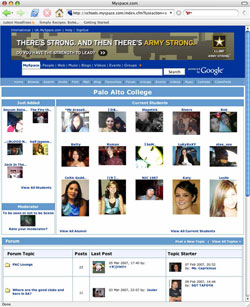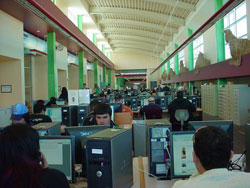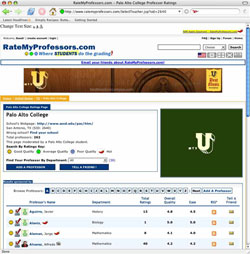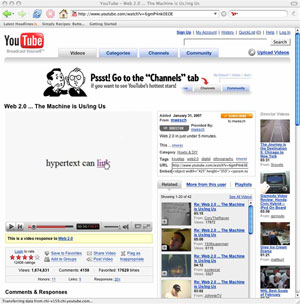Palo Alto College Computer/Network Coordinator Tom Duncan estimates that students evenly divide their time between leisure- and school-related matters on the Learning Resource Center’s 70 available and functioning computers.
“We have a lot of people using MySpace,” he said.
Learning Resource Center Work Study Crystalyn Wolf, a 21-year-old History major, said that the popular website creates problems of availability for the accessible computers with many students using the computers for fun and not for school work.
“Most of the time it’s filled up,” she said, in regards to the LRC. |
 |
| MySpace.com has easily established itself as the forerunner of the Web 2.0 generation of Internet applications. The social networking site has attracted a population of at least 154 million users worldwide with, on average, 300,000 new users registering daily since the website was first established in July of 2003.
Palo Alto College students have made sure that their school is fairly represented, creating a total of 3,267 MySpace pages that list Palo Alto College as that user’s current school.
After choosing to display their image and list their interests, hobbies and taste in films, music and literature, users are presented with the opportunities of messaging one another, linking pages with friends, hosting pictures for peer review and maintaining a blog.
Frank Montañez, a 19-year-old Palo Alto College student and lead singer of the Emocore rock band “Till Night Falls,” uses the services provided by Web 2.0 applications to aid in the success of his music group.
“[We] get a lot of fans coming up from different cities, states,” he said of users who frequent and critique his band’s music, adding that they have even been contacted by eager listeners from Mexico.
His band’s pages on popular outlets such as MySpace and PureVolume present visitors with a selection of recorded musical tracks that allows guests to sample and comment upon their work.
“It makes it way easier to sign with a record label,” said Montañez, noting that several of his MySpace contacts are representatives for independent record labels. |



